
Iain McGregor, Edinburgh Napier University
In 2014, it was estimated that 61% of UK students work during term time, for an average of eight hours per week, with a third working in excess of 30 hours per week (Bradley, 2014). Whilst international students are only allowed to work a maximum of 20 hours per week, there is no limit placed on the amount of hours home/EU students can work (UKCISA, 2014). The motivation for undertaking term-time work can vary widely, but the two main reasons are to minimise debt or provide some disposable income (Evans, Gbadamosi, & Richardson, 2014). The intention of the research reported here was to confirm the level of term-time paid work undergraduate students engaged in and to identify appropriate methods of academic support in order to minimise any negative effects.
The 1999 Cubie report made a recommendation that during term time Scottish students should work a maximum of 10 hours per week. The majority of students believe that term-time working has no negative effect on their studies and that it will enhance their employability (Curtis, 2007). Students who have work related to their studies have experienced positive effects upon their studies, and having a deeper understanding of this relationship could help reduce Higher Education attrition rates (Broadbridge & Swanson, 2005). Blasko, Brennan, Little and Shah (2002) warn that graduate employability is reduced for women who had worked part-time during their studies and for men who worked more than 10 hours per week during their term time.
Carney, McNeish and McColl (2005) found that as the number of hours a student works increases, there is a corresponding perceived negative effect upon their studies, mental and physical health. Mounsey, Vandhey and Diekhoff (2013) found little evidence of the incidence of depression being higher in working students, but did report a definite increase in anxiety and stress. Miller, Danner and Staten (2008) report that working more than 20 hours per week during term time could be linked to insomnia and alcohol and drug abuse. Roberts et al. (2000) suggest that there is a relationship between working longer hours outside studies and poor mental health. Carney et al. (2005) counsel that the most pressing issue for institutions to address is that of the student’s health.
There is a strong likelihood that term-time work will have a negative effect on the quality of the final degree and that it is a linear relationship, which negatively affects their careers as well (Callender, 2008). Hunt, Lincoln and Walker (2004) go further, stating that there is a measurable effect of a drop of three percent on the average degree mark and that this number increases as the number of hours a student works increases. Brennan, Duaso, Little, Callender and Van Dyke (2005) found that 72% of working students had been affected negatively by their term-time working arrangements and that 82% spent less time in private study. In contrast, Greenbank, Hepworth and Mercer (2009) warn that term-time work is often offered as an excuse for not engaging in group work and that many students were in fact “takeaway” students who preferred to “consume” their education at home, only attending campus when it was absolutely necessary.
Little work has been conducted by universities to meet the needs of students who work during term time, especially considering that courses are designed to be studied full-time (Moreau & Leathwood, 2006). Part-time work has been shown to occupy a similar amount of time as scheduled classes, but, surprisingly, universities continue to believe that their students are full time (Curtis & Shani, 2002). Robotham (2009) suggests that a full-time student is now a misnomer, and, as such, helping working students should be a standard part of any university provision.
Barron and Anastasiadou (2009) advise that universities should create closer links with term-time employers as well as more flexible timetables and provide employment advice. A number of well-established universities take active roles in helping students find term-time work through job shops, whilst others try to incorporate students’ part-time work either through gaining academic credit or by incorporating examples so as to illustrate appropriate soft skills. Little (2002) warns that both approaches could be disingenuous due to the possible negative effects upon a student’s academic achievement.
Curtis (2005) describes approaches taken by what Trowler (1998) refers to as “policy reconstruction” by academics, in order to support working students. The first was to schedule all of the classes for a course to run over two days per week, which meant that students either tried to confine all of their studying to the limited timetable or they felt unable to cope with the intense delivery. A second solution was to put notes and/or slides online, which students preferred to fully online delivery. Lastly, attempting to make the timetable more flexible was proposed, but there were inherent difficulties with different student cohorts and the availability of rooms and staff.
Metcalf (2003) puts forward a number of methods that universities could use to support students who work during term time such as recording lectures and making tutor support and deadlines more flexible. Hall (2010) confirms that working students would like an increased level of flexibility for the submission deadlines as well as more online materials and conveniently scheduled classes. Anderson (2006) advocates the use of subject-specific chat rooms as well as aiding students to become more computer literate so that they can benefit from online resources. Metcalf (2003) goes on to warn that these solutions cannot remedy the negative effects of term-time work upon students, but concedes that they can make it easier for students to cope.
Any support should be targeted and flexible, and a focus should be placed on helping students organise their work and studies without asking them to sacrifice additional time (Carney et al., 2005). With the exception of the 1999 Cubie report, almost all of the studies cited above have been relatively small scale, and their results should be considered carefully, as they are not representative of the higher education sector as a whole.
Two research questions were identified:
RQ1: How does term-time paid work affect higher education students’ studies?
RQ2: What can be done to minimise any negative effects of term-time paid work upon students?
A number of hypotheses arose from the literature, all of which were addressed:
H1: If a student works during term time, then this will have a positive effect on their confidence.
H2: If a student works during term time, then this will have a negative effect upon their ability to participate in extracurricular activities.
H3: If a student works during term time, then this will have a negative effect upon their marks.
H4: If a student works during term time, then this will have a positive effect upon their graduate level employability.
H5: If a student works during term time, then this will have a negative effect on their ability to attend classes.
H6: If a student works during term time, then this will negatively affect their physical health.
H7: If a student works during term time, then this will negatively affect their mental health.
H8: If a student works during term time, then this will negatively affect their social activities.
H9: If a student works during term time, then this will negatively affect their studies.
H10: If a student works during term time, then the University can provide appropriate academic support to minimise any negative effects.
There are two studies within this report. Study A was a self-completed questionnaire, and study B was a semi-structured interview. Study A identified the topics of discussion for study B.
One hundred and eighty-six undergraduate Creative Computing students took part in the study, of whom 62% had paid work during term time. The median age was 21, with a minimum of 18 and a maximum of 51. Seventy-two percent of the students were male and 28% were female. Students were approached when they were on campus during normal teaching hours (9am – 6pm). All of the students within the Edinburgh Napier University Creative Computing suite were approached; the response rate was 86%. Eighteen percent of the students were in first year, whilst 30% were in second, 30% were in third, and 22% were in their final year.
The informed consent form was approved by the ethics officer for the School of Computing. The form briefly outlined the research area and the permission being sought. In addition, participants were informed about the anonymity of the responses. The printed questionnaire comprised 24 questions.
The 24 questions addressed personal information, when and how often students undertook paid work as well as the effects of working and how the University could support students (see Table 1). Reviewing both the questions and the potential answers with teaching staff was initially used to validate the questionnaire. The next stage was to pilot the final version with 10 students, who were individually interviewed afterwards in order to confirm that their written responses corresponded with the intended meaning and that they clearly understood each question.
Table 1 Question topics for Study A
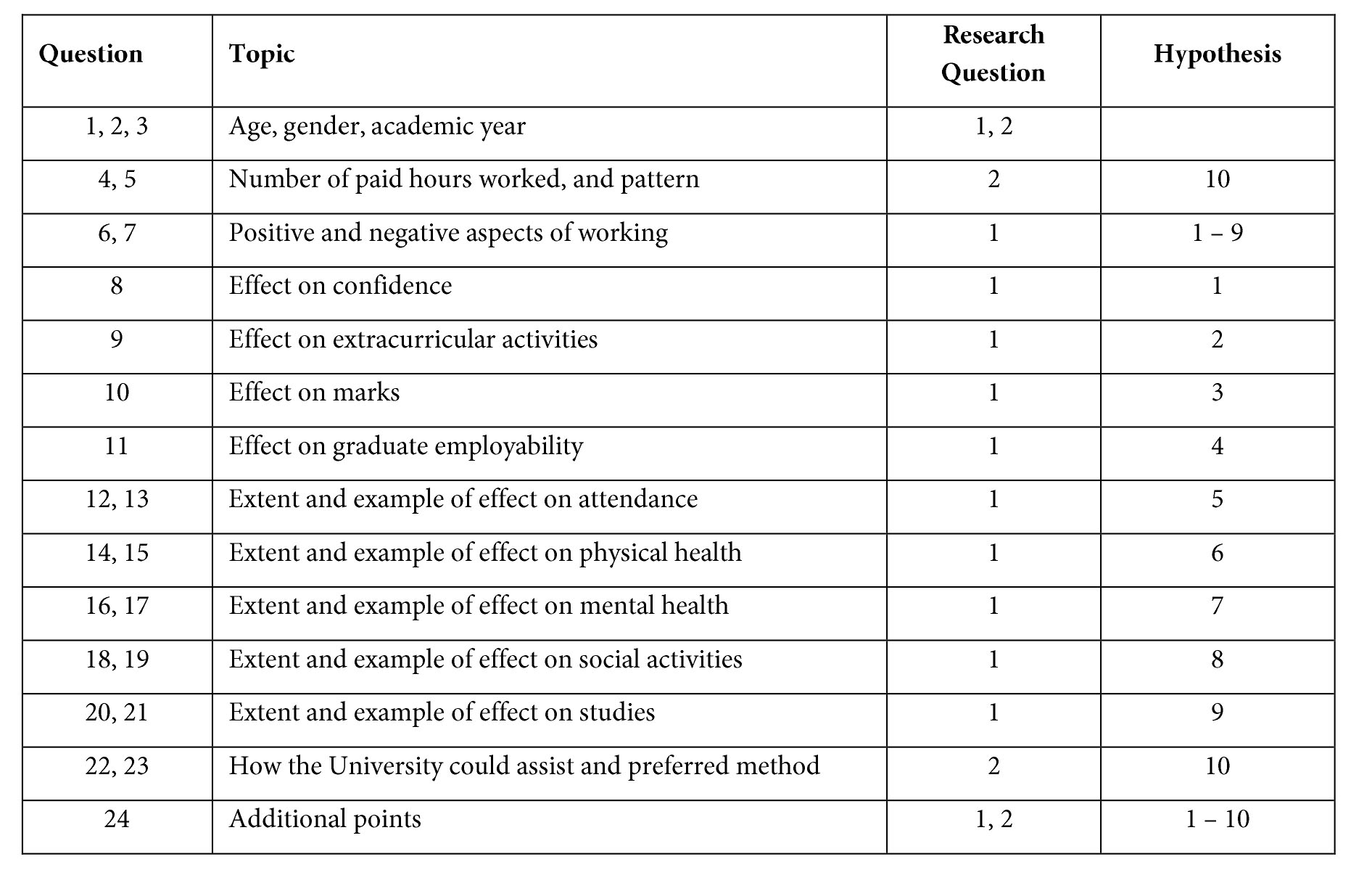
Participants took part individually and were not provided with any form of inducement. After providing informed consent, participants completed the printed questionnaire in their own time. Participants typically took less than 30 minutes to complete the questionnaire. Only students who were undertaking paid work during term time completed the entire questionnaire. Non-working students only completed the first four questions, in order to provide an indication of the ratio of working to non-working students.
There were 115 participants who reported that they worked during term time, which represents 62% of the population who took part in the study. The median number of hours worked was 16, with a minimum of three and a maximum of 68. Twenty-five percent of participants worked less than 11 hours per week, whilst 75% worked more than 10 hours per week.
In order to identify potentially optimal teaching slots, participants were asked to indicate when they were working. There was only a single day (Tuesday) when less than 10% of the participants were working, with more than 20% working on a Friday afternoon (see Table 2). The highest percentage of students (40%) worked on a Saturday and Sunday afternoon. There were only three hours per week when a student was not working: 3am on a Tuesday and 4am and 6am on a Wednesday. Mornings tend to have fewer students working than afternoons, but only by a small percentage.
Table 2 Hourly percentage of students working across a week

The majority of students (83%) when asked about the positive aspects of working stated money, with 21% citing that it provided a change from their studies. Work experience was important for 14% of respondents, with independence (9%), motivation (6%), time management (5%), social aspects (5%) and making contacts (1%) also being cited. Some students found that government funding was insufficient to support them, whilst a few worked in order to negate the necessity for a student loan or provide disposable income. Only a single student cited their work as being relevant to their studies.
With regard to negative aspects associated with working, the most prominent was lack of time (77%), followed by tiredness (18%) and stress (17%). Responses also included lower marks (3%), anti-social hours (3%) and unpredictability of shifts (2%).
When questioned about how their confidence had been affected by working during term time, 47% reported that it had a positive impact (see Figure 1). Neutral accounted for 35% of the responses, with 13% being negative and 4% being both positive and negative. Extracurricular activities were predominantly curtailed, with 55% of students being negatively affected by their work. Forty percent of working students were not affected, and only 4% found that their work had a positive impact on their extracurricular activities.
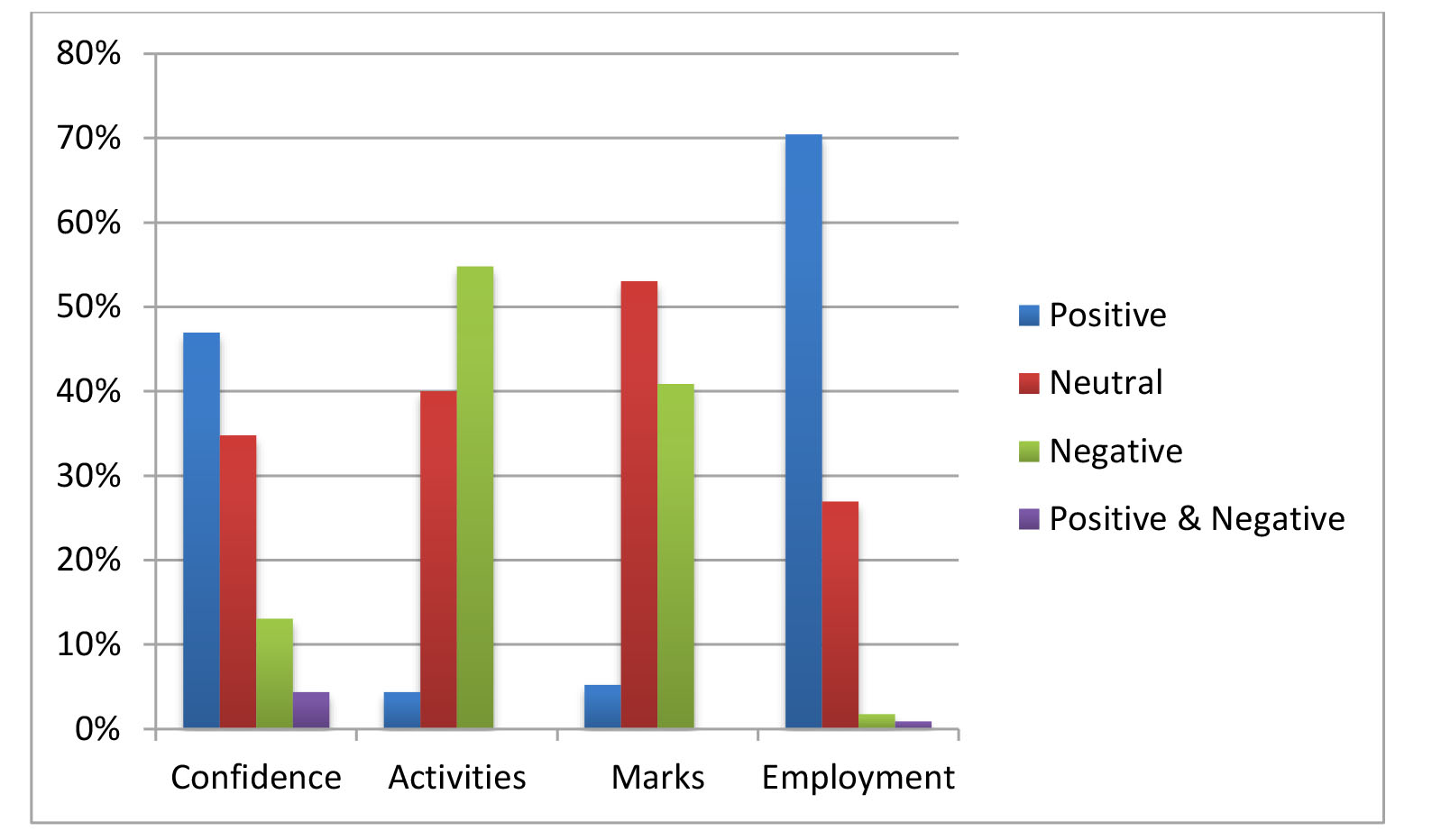
Figure 1 Effect of working during term time upon confidence, extracurricular activities, marks and graduate employment
Fifty-three percent of students reported that their marks had not been affected by working during term time, 5% percent felt that their marks had improved and 41% that their marks had fallen (see Figure 1). With regard to employability, 70% considered that their term-time work increased their postgraduate employability, with 27% being neutral, 2% negative, and 1% considering there to be both positive and negative effects.
When addressing attendance, 62% of working students responded that they had missed classes: 29% rarely, 26% occasionally and 7% often. Work commitments were the most common reason for missing classes at 39%, with sleeping coming next at 16%. Catching up with studies accounted for 3%, with lack of motivation and work-associated illness accounting for 1% each (see Figure 2). The remaining 2% did not respond.
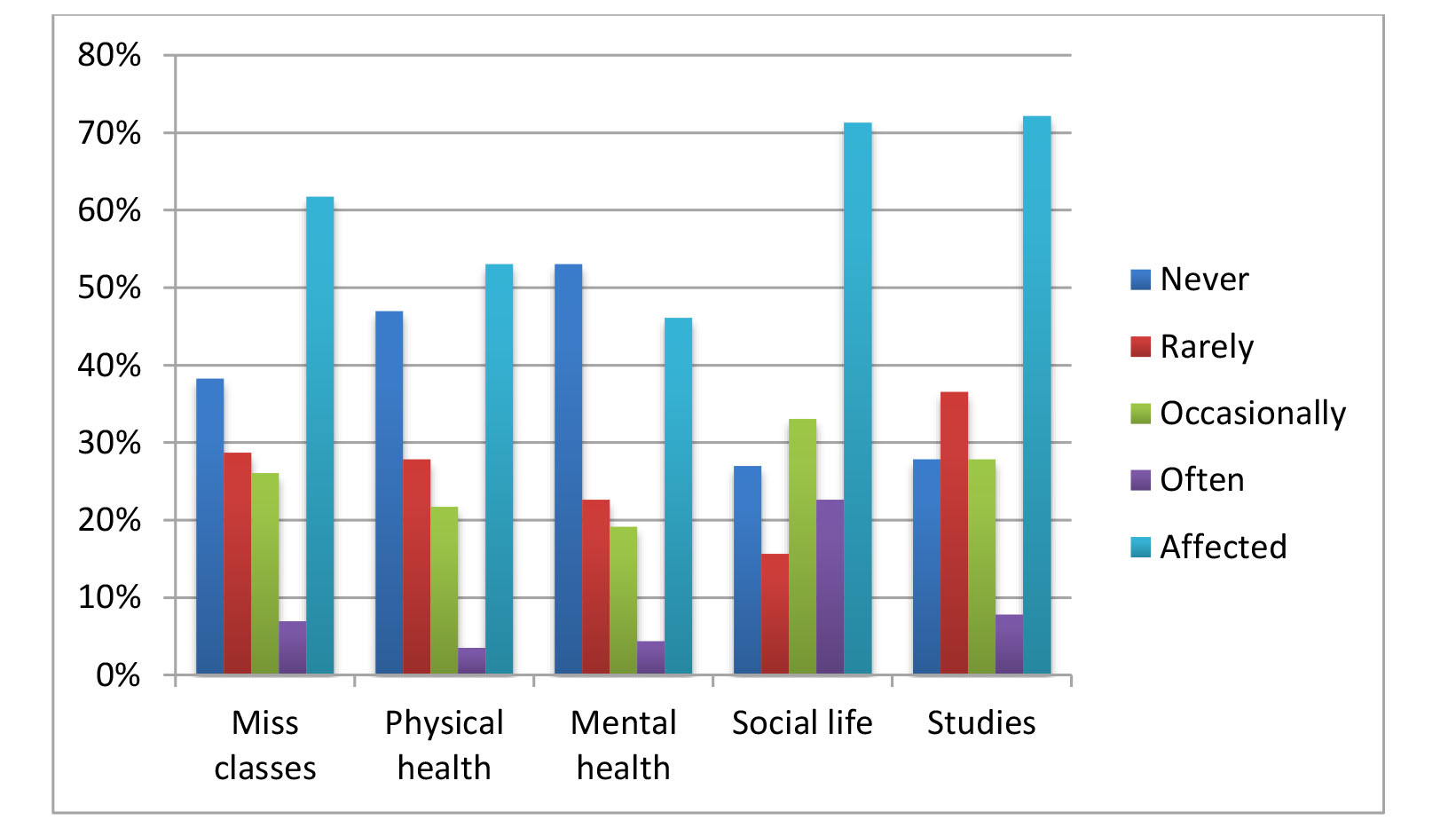
Figure 2 Effect of working during term time upon attendance, physical health, mental health, social life and studies
Physical health was negatively affected by working during term time for 53% of students: 28% rarely, 22% occasionally and 3% often (see Figure 2). Tiredness accounted for 18%; lack of sleep and general illness were reported at 11% and 10% respectively. Additional factors included stress (7%), lack of exercise (4%), poor diet (3%), accidents at work (3%) and panic attacks (1%).
Mental health was negatively affected by working for 46% of students: 23% rarely, 19% occasionally and 4% often (see Figure 2). The biggest issue was stress (39%), followed by depression (2%). Students reported that stress was caused by issues at work as well as not having sufficient time to prepare coursework, both of which were aggravated by lack of sleep. Issues at work included lack of supervisory experience, long/anti-social working hours, members of the public and general workloads. One student has to deal with abusive and violent people, which makes it difficult for the student to concentrate on their studies after incidents. Depression was reported as a linked to bullying at work, and stress. Two percent of respondents stated that their mental health had improved as work provided a welcome distraction.
Seventy-one percent of students reported that their social life had been affected by their term-time work: 16% rarely, 33% occasionally and 23% often (see Figure 2). Lack of time to socialise with friends is the most common issue (56%) due to either clashes with work or having to be up early for work the next day.
Studies were negatively affected for 72% of working students: 37% rarely, 28% occasionally, 8% often. The main reason was less time (44%), with work commitments requiring time to be sacrificed from coursework, group work or studying in general. In the run up to the Christmas period, coursework deadlines coincide with busy retailing periods, and there were incidences of students being coerced to work more hours by their employers. Tiredness (10%) was also an issue in that it made it difficult for students to focus on their coursework. Stress (4%) was particularly evident around submission deadlines, and attendance (2%) was affected by shifts clashing with classes, submissions and exams.
Fifteen percent of students thought that the University already provided sufficient support for students working during term time and that any further support was unnecessary (see Figure 3). In addition, a further 3% thought that it was impossible for the University to support students, as there is too much variation as to the type of support required, and that students are possibly too busy working to receive any help. Timetabling (18%) was identified as a suitable mechanism: all sessions and exams should be timetabled during the minimum available time, ideally on the same day or days. Funding (10%), whilst not being an academic issue, was cited, with students seeking a university-style job centre (4%) that both provided jobs on campus and advertised jobs suitable for students. An additional benefit would be that the University could step in on the students’ behalf when employers were pressurising them to work during timetabled classes. General one-to-one support (10%) was also requested, from counseling through to lecturer catch-up sessions. Additional online materials (7%) were highlighted as a suitable form of support – not only teaching materials, but the ability to submit coursework. Lastly, 5% of students suggested extensions of typically 1 – 2 weeks for working students who could provide proof of their employment.
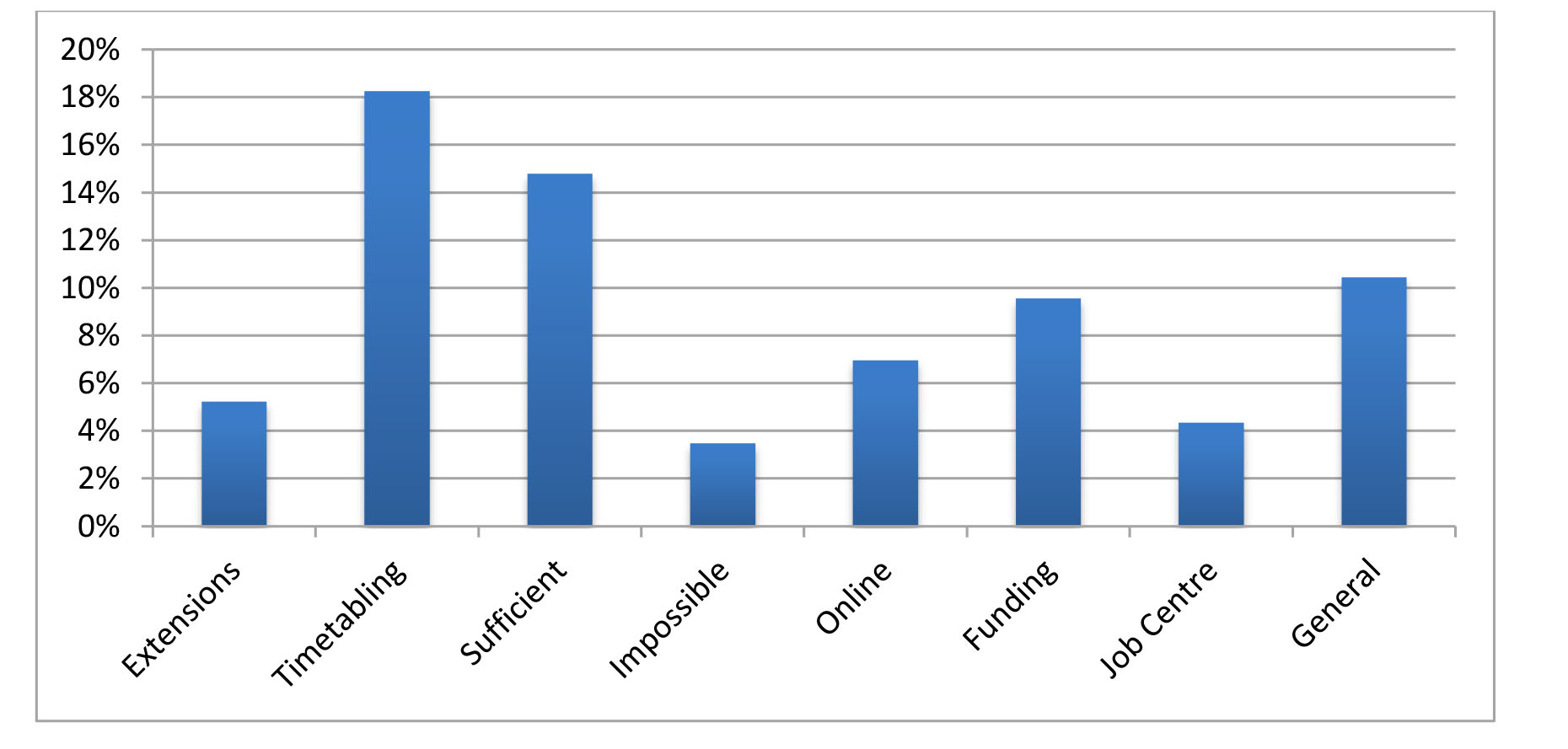
Figure 3 Methods of academically supporting students who work during term time
The majority of participants chose pre-recorded lectures (58%) from a pre-selected list of options that may help them academically (see Figure 4). The students also had the option of suggesting any other support method. Live broadcast lectures were requested by 48%, and email support accounted for 43%. Timetabling classes on a single day was the next most prevalent at 41%, followed by drop-in online video tutorials (39%). Lecturer office drop-in sessions and audio recordings had a popularity of 37% and 35% respectively. All of the other options were requested by fewer than a third of the participants: online forums (31%), lecture transcriptions (29%), lecturer online drop-in sessions (26%), optimal teaching hours (20%), instant messaging tutorials (14%) and telephone tutorials (2%). Other, which represented 7% of the responses, included running multiple teaching sessions, where students choose which to attend, as well as more teaching materials available in advance and advanced notice of timetables.
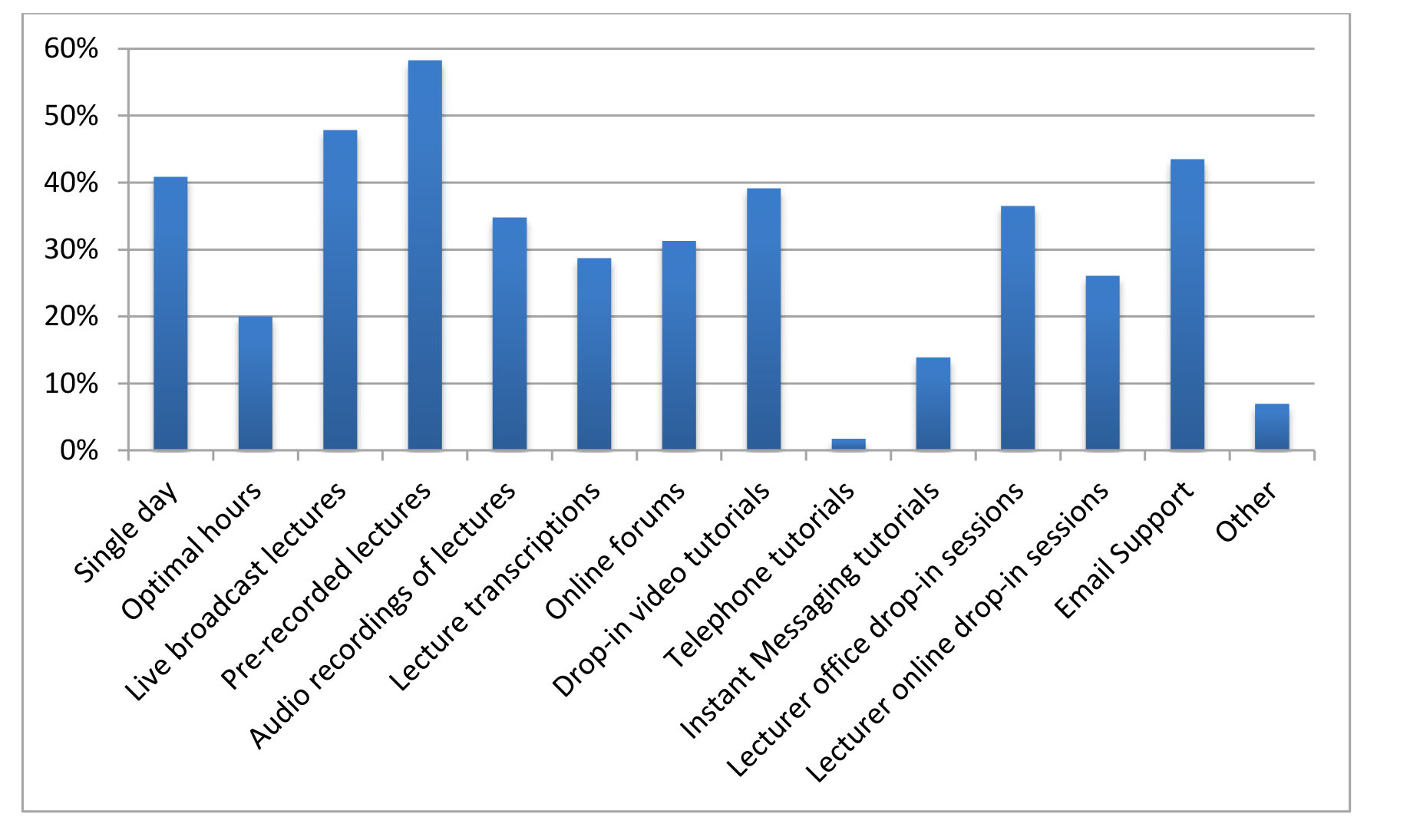
Figure 4 Preferred methods of academic support
After calculating the confidence intervals for each hypothesis, we can say that greater than 50% of working students who took part in this study believed that working during term time had a positive effect on their graduate employability as well as a negative effect on their attendance, social activities and studies. In addition, more than 50% of the working students who took part in the study also believe that the University could provide additional academic support for working students. The positive effects on confidence and negative effects on extra-curricular activities, marks, physical and mental health were inconclusive. Study B provided additional data to address hypothesis 10: If a student works during term time, then the University can provide appropriate academic support to minimise any negative effects.
Table 3 Confidence intervals
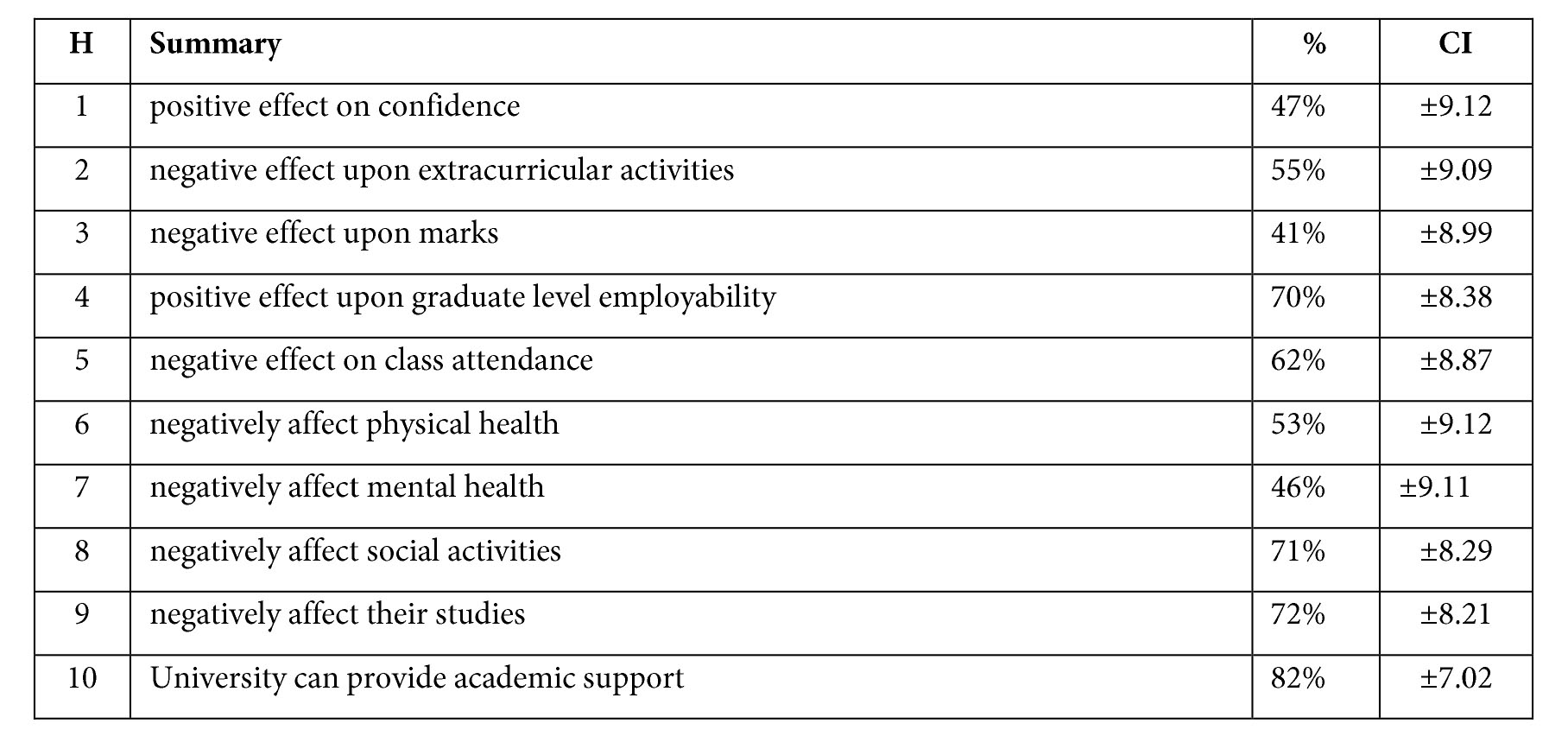
Study B was a series of semi-structured interviews, which further investigated the preferred methods of academic support identified by respondents in Study A. The study directly addressed Hypothesis 10: If a student works during term time, then the University can provide appropriate academic support to minimise any negative effects. Specifically, it provides suggestions as to the preferred methods of academic support provision for the working students who took part in the study.
Ten undergraduate Creative Computing students took part in the study, all of whom had paid work during term time. The median age was 23, with a minimum of 20 and a maximum of 37. Five of the students were male and five were female. Emails were sent out to Creative Computing students who had taken part in Study A until 10 students had agreed to be interviewed. Two students were in their second year of studies, two were in their third year, and six were in their final year. The students worked a median number of 17 hours per week during term time, with a minimum of six hours and a maximum of 37.
The informed consent form was approved by the ethics officer for the School of Computing. The form briefly outlined the research area and the permission being sought. In addition, participants were informed about the anonymity of the responses. The interview comprised 36 questions, which addressed students’ preferences for different forms of academic support.
All of the questions addressed the preferred methods of academic support that were identified in study A. All of the methods which were chosen by more than a third of the participants in study A were included in study B: pre-recorded lectures, live broadcast lectures, email support, single days, drop-in video tutorials, lecturer drop-in sessions and audio recordings of lectures. Questions addressed quantity, format, timing, interaction, depth, privacy and ideal delivery. Questions were grouped according to the proposed method of support.
Participants took part individually and were not provided with any form of inducement. All sessions were conducted via a Google+ Hangouts On Air, which allowed all of the sessions to be recorded, transcribed and then deleted. After providing informed consent, participants answered the questions in sequence. Participants were sent the questions in advance so that they were able to prepare their answers should they wish to do so. Interviews typically took less than 30 minutes to complete.
It could be argued that study A is a fair sample of how working Creative Computing students at Edinburgh Napier University currently wish to be supported academically due to the large sample size and response rate (86%). Study B needs to be treated with much more caution as only 10 students took part, which represents only 5% of the cohort. From that 5% it is possible to gain an insight as to when academic support sessions should run (see Table 4). Tuesdays and Wednesdays from 11am to 4pm are the most popular for on-campus classes. Live broadcast lectures are most popular on Wednesday or Thursday mornings from 9am to 11pm. Drop-in video tutorials are best held at 10am on any free weekday, and office drop-in sessions are ideally at either 2 or 4pm on a Friday or 2pm on a Monday. No students requested any form of academic support after 5pm or during the weekend.
Table 4 Preferred times for academic support

With regard to the duration and frequency of academic sessions per module per term, students requested 60-minute lectures for both live and recorded session (see Table 5), whereas 45-minutes was the preferred length for tutorials. Students would like lecturer drop-in sessions to be 75 minutes in length, and audio recordings of lectures should be around 37.5 minutes. There is an obvious preference both in length and number (22) for the lecturer drop-in sessions, although this does not indicate whether each session would be attended, more that the lecturer should be available. All other sessions were requested between 10 and 14 times per module per trimester.
Table 5 Preferred length in minutes, and quantity for academic support

For prerecorded lectures, there was no consensus as to whether the lectures should be slides with a voice-over, or a video of a lecturer in a classroom in front of projected slides – there was no clear preference. Some students find pre-recorded lectures to be “quite often quite dry”, as if the “lecturer is going through the material, and there’s not really any sense of engagement” (Participant (P) 04). When audio recordings were made of lectures, some students requested edited highlights, whilst others wanted the full lecture as well as the inclusion of any questions and answers. A concern was with what should be edited: “Keep the main points, but in more detail, like edited highlights, but in the detail that they were talked about” (P08). The preferred file format was MP3, as “it won’t take a lot of space” (P03).
For email support, the median response time for lecturers to respond to an email was 4.5 hours, with the minimum time being an hour and the maximum 48 hours. There was no consensus as to whether responses should be concise or in depth: it “depends what you are asking really” (P02), “I don’t think lecturers should give everything away” (P01). The importance of relevance was a factor, as they had regular experience of a lecturer responding with “nonsensical” YouTube links (P05). A Skype invitation to discuss the issue further was considered “helpful” (P07).
With drop-in video tutorials, students would like the sessions recorded, and there was an almost equal consensus between instant messaging, webcam and voice only as the preferred method of interacting during the session. Students would like to be able to screen share, and for the sessions to be informal, with the opportunity for lecturer demonstrations. “If other students would like to join in as well and offering feedback that would be great” (P06), especially to “help each other improve” (P09). For the lecturer drop-in sessions students, would like them to be in a lecturer’s office, with only a couple of students requesting that the sessions be private, whilst others would like to be able to book sessions in advance. A key factor is that it is “a friendly environment, so that the students won’t feel too embarrassed to ask questions, and the lecturer will answer in a friendly way as well” (P10).
Relating the results to hypothesis 10, it is possible for the University to provide appropriate academic support to minimise any negative effects for a student who is working during term time. Clear guidelines as to preferred content and delivery methods have been derived, but there is no indication about the effectiveness of any support.
Students would like all online sessions to be recorded so that they can refer to them later. There is no real preference with regard to how students communicate within sessions: instant messaging, webcam and audio only are almost equally preferred; fortunately, all three coexist well within video conferencing software. The School of Computing’s current guideline of responding to student emails within 24 hours during weekdays does not match the student expectation, which is 4.5 hours, with almost a third of students wanting a response within an hour. There were no novel ways of supporting students suggested by participants in either study A or study B.
Of the 186 students who took part in the study, 62% worked during term time, which is similar to the figure of 61% reported by the Santander study (Bradley, 2014). However, students who took part in this study worked a median of 16 hours, which is double that of the Santander study and six hours more than the recommendation made in the 1999 Cubie report. Eighty-three percent of students were working for financial reasons such as food, accommodation and bills, which is higher than the 55% reported in the 2012 Endsleigh study (Richmond, 2013). Only 14% of students were working in order to gain work experience, in contrast with 53% of students in the 2013 Endsleigh study who were motivated to work in order to improve their graduate employability (Gil, 2014).
Forty-seven percent of students stated that working had a positive effect on their confidence, an effect that has been highlighted elsewhere (Watts & Pickering, 2000). In addition, 70% of the participants believed that working would have a positive effect on their graduate employability, which has been shown to be a positive factor within interview environments (Garouste & Rodrigues, 2014). However, the personal cost is high for students, with 77% of working students experiencing a lack of time, which had a negative effect on the ability to participate in extracurricular activities for 55% of the working students. Only 41% of students considered that their marks had been affected, but 62% had missed classes due to working during term time. Fifty-three percent of students felt that their physical health been negatively affected by working, with 46% of students reporting that their mental health had also diminished, which partially supports the findings of Carney et al. (2005). Finally, 71% of students have had their social life negatively affected by their working during term time, with 72% believing that it has negatively affected their studies, which corresponds with the findings of Richardson, Evans and Gbadamosi (2014).
These two studies suggest that it is possible to support working students more during their studies and that the solutions are relatively simple. There is no suggestion that the methods of support highlighted in this paper will lessen the negative effects of working while studying, but they could be used to provide what students think might assist them to balance paid work and studying during term time. An overarching desire for flexibility is evident amongst working students (Evans et al., 2014), and almost all of the recommendations can be achieved within existing infrastructure – it is more a case of rebalancing. Lectures can either be pre-recorded or broadcast live; many computers now have built in cameras and microphones in order to achieve this, and along with free services like Google+ Hangouts On Air the costs are minimal. The results suggest that students would like less of a focus on lectures and more on one-to-one supervision, which could be easily achieved by transferring time from lectures to drop-in sessions. The most difficult suggestion to implement is that of timetabling: increasing student numbers and a limited number of classrooms makes it almost impossible unless the University invests in more teaching space. In addition, Wednesday afternoon is a popular timeslot for students to attend university and the introduction of Wednesday afternoons being devoted to sport limits the timetable still further.
The results specified in this study might be of interest to other groups of students who may require support with their studies, such as those with health issues, disabilities or care responsibilities. Investment in asynchronous delivery could be used to assist any student who is not regularly able to attend timetabled sessions.
Future research will concentrate on developing and testing the methods of delivery proposed above. Live lectures will be recorded and edited according to the guidelines detailed above and then presented to focus groups of students in order to establish best practice. In a similar manner, pre-recorded lectures will be created and tested. For the online tutorials and drop-in sessions, individual student feedback will be sought after each session in an iterative manner, in order to establish an optimal approach. It is hoped that this approach will benefit all of the students, not just those that are working during term time. Over a longer period, attendance, module results and student questionnaires will be reviewed in order to establish any trends and cross-reference them with delivery methods.
This study set out to establish how term-time paid work affects higher education students’ studies and what can be done to minimise any negative effects. Working during term has a perceived positive effect on graduate employability as well as a negative effect on attendance, social activities and studies. Working students also believe that the University could provide additional academic support for working students through pre-recorded lectures, live lectures, drop-in video tutorials and lecturer drop-in sessions. Whilst the results only apply to a small group of students within the University, the extent of the effects, and possible solutions, have been identified in order to minimise any negative effects.
Dr Iain McGregor is a lecturer and researcher in Sound Design within the School of Computing at Edinburgh Napier University. Iain has been teaching about sound since 1990 and is the programme leader for the undergraduate and postgraduate degrees in Sound Design.